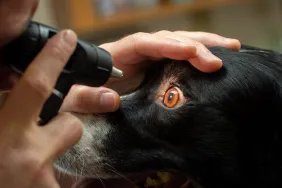Estrus symptoms in dogs happen when a dog shows signs of being in heat even when she has been spayed. However, dogs with this condition cannot get pregnant.
Usually, the cause of the condition is ovarian tissue left behind after being spayed.
Technically, estrus symptoms are called ovarian remnant syndrome.
If you see the signs of estrus symptoms in your dog, then get to a veterinarian for a proper diagnosis and treatment.
Here’s what you should know about the symptoms, causes, and treatments for the condition.
Symptoms of Estrus Symptoms in Dogs
Estrus symptoms in dogs produces a range of symptoms. For instance, some of the most common symptoms include:
- Swollen vulva
- Vaginal bleeding
- Changes in behavior
- Vaginal discharge
- Attracting male dogs
Causes of Estrus Symptoms in Dogs

The cause of the condition is not removing both ovaries during the spaying operation. In most cases, this is due to a surgical error.
Additionally, not removing all of the ovarian tissue can cause estrus symptoms.
Finally, a dog may have an extra ovary. This can cause the condition — but it is rare.
Treatments for Estrus Symptoms in Dogs
Firstly, your vet will ask about your dog’s symptoms. Secondly, they will need to know the details of when they were spayed.
Thirdly, your vet will conduct a full physical examination. After that, they will take blood and urine tests.
Generally, high levels of estrogen and progesterone are indicators of estrus symptoms.
In some cases, an ultrasound might be used. This is to look for any abnormal ovarian tissue.
Normally, treatment for the condition is a surgery. This is to remove any remaining ovarian tissue.
Most times, a dog will be prescribe pain medication after this surgery.
As always, stick to the exact dose and frequency instructions your vet gives you. Also, complete the full course of medicine.
If you’re curious to know more about spaying and neutering, read our article about common facts and myths here!
Have you cared for a dog who suffered from this condition? How did your vet help your dog recover? Let us know in the comments section.









